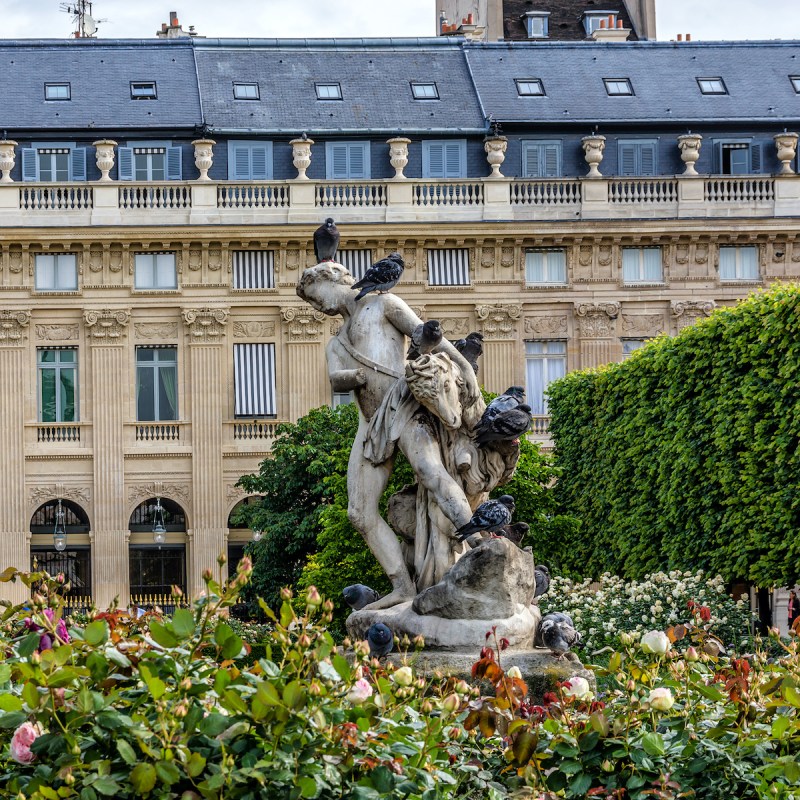
If you find yourself in Paris and heading to the Louvre, schedule an hour of extra time to head in the opposite direction from the crowds. Sometimes as a tourist, there is an unknown treasure located very close to a predetermined destination. Such is the case with the Palais Royal. Situated in the first arrondissement not far at all from the Louvre, this once royal palace has courtyards and a stunning garden to explore. The palace building itself is not open to the public.
Videos by TravelAwaits
I currently live close to the Palais Royal and find on my long walks through Paris that I circle through the courtyards and garden on a daily basis. Here is why I find this Paris location so interesting and inviting.
The Palais Royal And Its History
It was Cardinal Richelieu who built the Palais Royal. Originally called the Palais Cardinal, this 17th-century palace was completed in 1639. Cardinal Richelieu was an advisor to King Louis XIII and wanted a residence in close proximity to the Louvre, which was where the royal family lived. Being close to the King, Cardinal Richelieu could wield his mighty influence over the religious matters of France. In 1642, just a few years after the Palais Cardinal was completed, Cardinal Richelieu died and willed his palace to Louis XIII. It was then that the name changed to the Palais Royal.
When Louis XIII died, the Palais Royal was inherited by his two children, Louis XIV and his brother Philippe d’Orleans.
About one hundred years later in 1773, the Palais Royal fell into the hands of Louis-Philippe d’Orleans, who was a big spender and needed money. He undertook a bold plan of real-estate development and subdivided the wings of the palace facing the garden into apartments and stores.
The Palais Royal became a gathering place for Parisians. By 1789, the gardens of the Palais Royal were the liveliest place in Paris and were referred to as the Capital of Paris! The Palais Royal was a meeting place for intellectuals to share ideas. The aristocracy came to buy the latest fashions, stroll, and attend a play at one of the two theatres. During the day, the Palais Royal was the place to see and be seen.
In the evenings, gambling houses and brothels provided the main entertainment at the Palais Royal. Being that it was a private residence, no police were allowed to enter and monitor the activities.
With a long and varied history, the Palais Royal eventually fell out of favor and became property of the State in the late 1800s. It was abandoned for almost a century until the State Council and the Ministry of Culture moved their offices into the Palais Royal. In the 1980s, it was the Minister of Culture, Jack Lang, that initiated the art installations that eventually brought Parisians back to the Palais Royal.

The Buren Columns (Les Colonnes De Buren)
One of the reasons that the Palais Royal is known today is the Buren Columns or Les Colonnes de Buren. Situated in the inner courtyard (the Cour d’Honneur) of the Palais Royal are 260 octagonal black and white striped marble columns. They make an immediate impression upon sight.
Created by the French artist Daniel Buren in 1986, the columns were not well accepted nor liked by Parisians, even though they replaced a parking lot. Despite the controversy, the art installation, formally known as Les Deux Plateaux, remained in place. Over the years, the striped Buren columns have become a symbol of Paris.
What makes the Buren Columns such a striking sight are the varying heights of the marble columns and the contrast between this modern art installation and the classic architecture of the Palais Royal.
At all times of the day, the Buren Columns draw a steady stream of people: families with young children playing on and amidst the columns, business people striding across the courtyard briefcases in hand, photographers searching for different angles, fashionistas modeling the latest style, and Instagrammers posing for the most imaginative shot. All visitors find a creative way to interact with the Buren Columns.
The Mirror Ball Fountains (Les Spherades)
In between the Cour d’Honneur and the glorious gardens of the Palais Royal is a second courtyard. This courtyard, the Cour d’Orleans, contains an art installation that creates a completely different experience to Buren’s columns. Belgian sculptor Pol Bury (1922-2005) designed two identical fountains, Les Spherades, each containing 10 silver reflecting spheres arranged on a platter sitting in a pool of water. It is the gentle sound of the flowing water and the magnificent reflections on the stainless steel balls that hold your attention. Look for the beautiful architecture and the clouds reflected back at you!

The Palais Royal Garden
The Palais Royal Garden is a hidden treasure in Paris. This quiet and stately royal garden that has been in existence for centuries provides a tranquil place to relax, read, and take a little break from sightseeing.
If you happen to be in Paris in the springtime, the magnolia and cherry blossom trees in full bloom are breathtaking. The Palais Royal Garden is well manicured with colorful annuals and perennials in constant bloom. Sit on one of the benches under the linden trees or pull up a classic Parisian green metal chair to the central fountain and just breathe.
The Palais Royal Garden is the most literary garden that I know of in Paris. Across the backs of the benches are poetic quotes. Pause. Fire up Google Translate and see what these words might mean to you.
A unique addition to the Palais Royal Garden are the attached double chairs that face each other. I like to think of them as love seats. The art project called Les Confidents was created by French Canadian artist Michel Goulet. Just imagine heading to the park with a friend or partner, sitting facing each other, and diving into a deep conversation. These chairs invite intimacy. Also known as “The Chair Poems,” they too offer a poetic quote if you are looking for a conversation starter!
The Arcades Of The Palais Royal
Surrounding the Palais Royal Garden on three sides are covered arcades or galleries. Each with its own name, the Galerie Montpensier, Galerie Valois, and rue de Beaujolais, the galleries are great fun to stroll. These long “streets” are lined with high-end boutiques of renowned designers, antique and art dealers, and perfumers. The coffee shop Cafe Kitsune serves up one of the tastiest coffees I have savored in Paris.
Along the rue de Beaujolais, look for one of the oldest restaurants in Paris, Le Grand Vefour. Established in 1784, this historic restaurant has served plenty of French superstars over the centuries, including Napoleon and Josephine. A two-starred Michelin restaurant, Le Grand Velour’s signature dishes include stuffed pigeon, Pigeon Prince Rainier III, and a sweet artichoke pie. This restaurant is a definite Parisian splurge!
Just down from Le Grand Vefour along the rue de Beaujolais, keep your eyes open for the plaque at #9 where the famous French author Colette lived. She overlooked the Palais Royal and the Garden. I can only imagine how inspired she was to write!

Pro Tip
Close to the Palais Royal is the Galerie Vivienne, at 5 rue de la Banque. This historical monument is one of the most elegant covered passageways in Paris. Built in 1823, its glass ceilings and exquisite mosaic-covered floors make for a unique shopping experience.
Where To Eat Near The Palais Royal
Le Grand Colbert, 2 rue Vivienne: This classic French restaurant and the historical monument is impressive to enter. The 19-foot-high walls, mosaic-covered floors, and Pompeiian-style paintings on wood create an authentic French atmosphere to enjoy a delicious meal.
Le Bistrot Vivienne, 4 rue des Petits Champs: This historic and classic French bistro is also sure to provide a perfectly Parisian experience, including a fireplace on the main floor and armchairs in which to settle back and relax with a drink in hand.
Related Reading:
